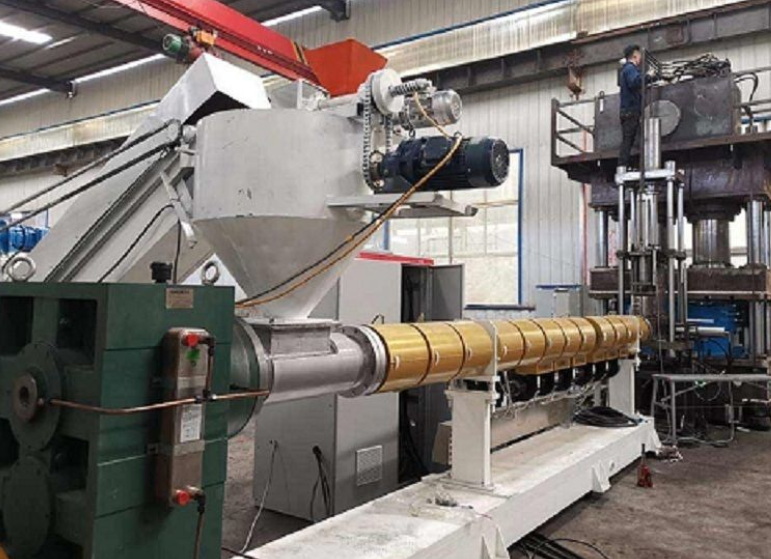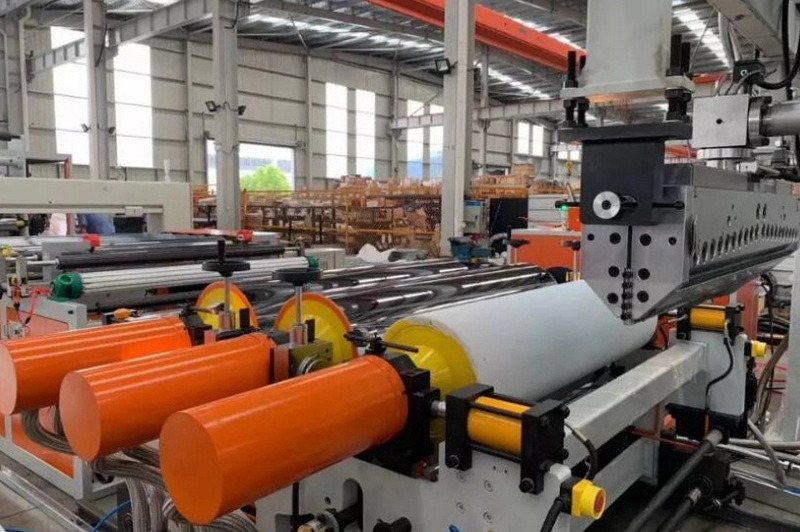Content Menu
● Introduction to Extrusion Process
>> Raw Material Selection and Preparation
>> Extrusion
>> Cooling and Sizing
>> Cutting
● Role of Tubing Perforator in Extrusion Process
>> Tubing Perforator Basics
>> Benefits of Tubing Perforator
>> Integration with Downstream Equipment
● Extrusion Downstream Equipment
>> Critical Components of Downstream Processing Equipment
>> Applications in Pipe and Profile Manufacturing
>> Downstream Solutions for Specialized Products
● Innovations in Extrusion Technology
>> High-Output Extruders
>> Advanced Materials and Applications
● Conclusion
● Frequently Asked Questions
>> 1. What is the role of a tubing perforator?
>> 2. How does a tubing perforator work?
>> 3. What is the purpose of downstream equipment in extrusion?
>> 4. How does precision control affect extrusion?
>> 5. What are the benefits of using advanced cutting solutions in extrusion?
● Citations:
The extrusion process is a versatile manufacturing technique used to produce a wide range of products, including tubing, pipes, and profiles. It involves forcing a material, typically plastic or metal, through a die to achieve the desired shape. In this process, various types of equipment play crucial roles, and one such device is the tubing perforator. This article will explore how a tubing perforator contributes to the extrusion process, particularly focusing on its role in conjunction with extrusion downstream equipment.

Introduction to Extrusion Process
The extrusion process begins with the selection and preparation of raw materials. These materials are then melted and forced through a die to form the desired shape. The extrudate then passes through various downstream equipment for cooling, sizing, and cutting before it is ready for use.
Raw Material Selection and Preparation
The first step in the extrusion process is selecting the appropriate raw material. Common materials include polyethylene (PE), polyvinyl chloride (PVC), and thermoplastic elastomers (TPE). These materials are typically in the form of pellets or granules and are fed into a hopper before being conveyed to a heating zone.
In the heating zone, the material is melted using heat and mechanical shear. This process is crucial for achieving the right viscosity for extrusion. The extruder, which consists of a screw and barrel, plays a key role in this process. The screw design is critical for ensuring consistent material flow and efficient melting.
Extrusion
Once the material is melted, it is forced through a specially designed die. The die determines the shape and size of the tubing. The extrusion process can be either single-screw or twin-screw extrusion, depending on the complexity of the tubing. Single-screw extruders are ideal for simple materials like PVC, while twin-screw extruders offer more control and flexibility, especially for multilayer or mixed materials.
Cooling and Sizing
After the molten material passes through the die, it enters a cooling zone. The tubing is cooled using air or water to solidify the material and maintain its shape. Cooling is crucial to prevent deformation and maintain dimensional accuracy. Vacuum sizing is a common method used in pipe manufacturing, where the pipe is cooled and sized in a vacuum tank to achieve precise dimensions.
Cutting
After sizing, the continuous length of tubing is cut into desired lengths using a cutting device. The cutting device can be a saw, knife, or laser cutter, depending on the material and tubing specifications. Precision cutting is essential to ensure that the tubing meets the required specifications without generating excessive waste.
Role of Tubing Perforator in Extrusion Process
A tubing perforator is not typically used in the standard extrusion process but is more commonly associated with well intervention operations. However, understanding its function can provide insights into how similar tools might be integrated into specialized extrusion processes.
Tubing Perforator Basics
A tubing perforator is a mechanical device designed to perforate standard and heavy wall tubing under pressure. It is deployed into wells by conventional means and requires no explosives, eliminating the risk of casing perforation.
Benefits of Tubing Perforator
1. Greater Tubing Penetration: The perforator allows for deeper penetration into the tubing, which can be beneficial in certain applications.
2. Positive Indication of Perforation: Upon tool removal, there is a clear indication that perforation has occurred.
3. Safety Release Mechanism: The tool can be retrieved from the well without causing additional perforations.
4. Utilizes Upward Jarring Impacts: The perforation action is achieved through upward jarring impacts.
Integration with Downstream Equipment
While tubing perforators are not directly integrated into the extrusion process, they illustrate how specialized tools can enhance the functionality of tubing in various applications. In the context of extrusion downstream equipment, devices like pullers, cutters, and cooling troughs work together to ensure that the extruded tubing meets precise specifications.

Extrusion Downstream Equipment
Downstream equipment in the extrusion process includes:
- Pullers: These gently grip and draw the extrudate from the extruder through the cooling and sizing equipment.
- Cutters: Devices used to cut the tubing into desired lengths.
- Cooling Systems: Provide controlled cooling to maintain pipe shape and integrity. Cooling methods include air cooling, water baths, or chilled rollers.
- Sizing Devices: Ensure the tubing has the desired dimensions. Vacuum calibration tables are commonly used for precise sizing.
Critical Components of Downstream Processing Equipment
1. Cooling Systems: These are used just after the extrusion dies to cool down and harden the extruded substance while maintaining its desired shape and properties.
2. Pullers: Pullers are devices that pull out material from one machine to the next. They are built with accuracy in mind, so they can consistently do this job without any variations.
3. Cutters: Cutters are machines that cut products into the required sizes depending on the application. Different materials will, therefore, require different types of cutters.
4. Windners: Winders come into play when long lengths need rolling up after creation before storage or transportation.
Applications in Pipe and Profile Manufacturing
In the manufacturing of pipes and profiles, incorporating downstream equipment into the process greatly increases its production abilities. Vacuum calibration tables, haul-offs, and saws are among the most crucial downstream parts, ensuring that pipes and profiles maintain accurate dimensions with smooth surfaces.
Downstream Solutions for Specialized Products
To comply with strict industry standards and specific application requirements, downstream solutions for tailor-made products like medical tubing, car parts, and custom profiles need an individualized approach. In order to produce these specialized items, advanced downstream equipment such as precision cutters, coilers, and cooling systems must be used.
Innovations in Extrusion Technology
Recent innovations in extrusion technology have focused on improving efficiency, reducing costs, and enhancing product quality. Modern extruders are designed to be energy-efficient, reducing operational costs while maintaining high output levels. Customizable designs allow manufacturers to create pipes in a wide range of sizes, thicknesses, and materials, meeting the specific needs of different industries.
High-Output Extruders
For industries requiring large volumes of pipes in a short time, high-output extruders offer numerous advantages. These machines provide precise control over pipe dimensions, ensuring consistent quality and minimizing waste. They are scalable to meet the demands of high-volume production lines.
Advanced Materials and Applications
The extrusion process is not limited to traditional materials like PVC and PE. Modern applications include the use of advanced materials such as thermoplastic elastomers and composite materials. These materials are used in specialized applications like medical devices and automotive components, where dimensional accuracy and surface finish are critical.
Conclusion
In conclusion, while a tubing perforator is not directly involved in the extrusion process, understanding its functionality highlights the importance of specialized tools in enhancing product capabilities. The extrusion process relies heavily on extrusion downstream equipment to produce high-quality tubing and pipes. These equipment components work together to ensure precision, efficiency, and sustainability in manufacturing.

Frequently Asked Questions
1. What is the role of a tubing perforator?
A tubing perforator is used to perforate tubing under pressure, typically in well intervention operations. It provides a safe and efficient way to create holes in tubing without using explosives.
2. How does a tubing perforator work?
The perforator uses upward jarring impacts to create holes in the tubing. It is designed with a safety release mechanism to prevent accidental perforations during retrieval.
3. What is the purpose of downstream equipment in extrusion?
Downstream equipment, such as pullers, cutters, and cooling troughs, is crucial for ensuring that the extruded tubing meets precise specifications. It handles cooling, sizing, and cutting of the tubing.
4. How does precision control affect extrusion?
Precision control in extrusion is essential for maintaining the desired dimensions and quality of the final product. It ensures minimal waste and consistent output.
5. What are the benefits of using advanced cutting solutions in extrusion?
Advanced cutting solutions, such as chipless cutting and dustless chamfering, reduce material waste and contribute to a more sustainable production process. They also enhance product quality and reduce operational costs.
Citations:
[1] https://testbook.com/mechanical-engineering/extrusion-process-and-types
[2] https://www.adremac.com/pipe-extruders-comprehensive-guide-to-technology-applications-and-innovations-in-plastic-pipe-manufacturing/
[3] https://jieyatwinscrew.com/blog/downstream-equipment/
[4] https://paulmurphyplastics.com/industry-news-blog/extrusion-process-working-types-application-advantages-and-disadvantages/
[5] https://www.qenos.com/internet/home.nsf/(LUImages)/TG7Pipe/$File/TG7Pipe.pdf
[6] https://www.bausano.com/en/downstream-equipment
[7] https://www.tfgusa.com/understanding-extrusion-a-fundamental-manufacturing-process/
[8] https://itib-machinery.com/products/downstream-and-ancillary-equipment/perforators/
[9] https://kautec.net/products/extrusion/downstream/
[10] https://www.gillardcutting.com/applications/plastics-extrusion
[11] https://www.advancedextrusion.com
[12] https://www.youtube.com/watch?v=Y75IQksBb0M
[13] https://qdcuishi.en.made-in-china.com/product/UwZGfFCviOpd/China-Extrusion-Line-Pipe-Grooving-Corrugated-Pipe-Perforator-Machine-Machine.html
[14] https://runa.co.il/downstream-equipment/
[15] https://en.wikipedia.org/wiki/Extrusion
[16] https://drts.com/what-is-the-pipe-extrusion-process/
[17] https://www.rdnmfg.com/products/combination-puller-cutters/
[18] https://www.goodfishgroup.com/the-step-by-step-process-of-plastic-extrusion
[19] https://sicaindia.com/downstream-pipe-extrusion-equipment/
[20] https://study.com/academy/lesson/extrusion-definition-process-examples.html






















